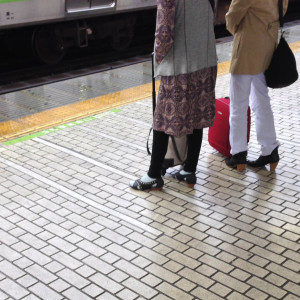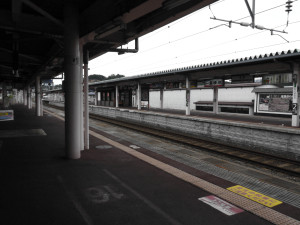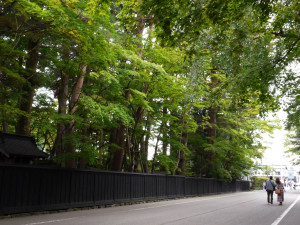Today worried me. (Worry is a theme of this trip.) This was my last day in Tokyo; I had to get up to Kakunodate, about 3 hours north of Tokyo. I knew I had to take a single bullet train from Tokyo Station, but I wanted to get to Kakunodate by lunch, which meant a fairly early start.
To get to Kakunodate by lunch time, I’d have to leave Tokyo around 9:00am. This meant facing the legendary Tokyo rush hour, with “pushers” shoving riders onto packed trains.
I didn’t relish it, but I decided to risk it anyway so I could get there at a reasonable time. I got on the subway, which was almost empty. That’s when I remembered the day. It was Saturday.
Now, most workers in Japan worked six days a week until recently, so this might not have changed things much.
I arrived at Ueno Station to head down to Tokyo, and thanks be to God, the train was…full, but not packed. At least a few inches separated each rider.
At Tokyo Station, I made a tactical error. While I had planned to reserve a seat, when I arrived I saw a sign for the train I wanted (Akita Shinkansen), leaving in 10 minutes, so I just headed up there, flashing my JR Pass as I went. And it was there that I experienced the thoughtful design of the Japanese train system.
First off: embedded tiles in the floor show you where to stand for the train doors. That’s the precision of the system: the train always stops at exactly the same spot, every time.
Because of this, signs hang above the platform for each car, telling you where to stand if you have a reservation.
Thank goodness all the signs are in English. The sign above the train said, “Reserved Seats Only.” I ran down the platform to the next car. Same sign. Same with the next, and the next.
So. Back donwstairs, flashing my JR Pass again, to find the JR Information Desk. Found, I stood in line for a few minutes–realizing, of course, that the train had just left the station–and asked for the next Akita Shinkansen.
The next one left in 15 minutes. Wow.
Back upstairs, I boarded my first bullet train. On one hand, it’s like any train: nice seats on a vehicle that gets you from point A to point B. It’s the efficiency and cleanliness of the Japanese trains that get to you. It’s the fact that everything is done right.
Let me explain with the bathrooms. There are several toilets in the back of each car, and one shared sink. The sink provides water from a spigot in the center, soap from a spigot on the left, and hot air drying from a fan on the right. All of it touchless, of course, and all of it working flawlessly. So you place your hand in the middle to wet your hands, slide to the left for soap, slide back to the middle to rinse, and slide further to the right to dry your hands. And the door to the sink? Just happens to be on the right side.
Okay, one more example: a fold-down cup holder sits on the back of every seat. And it remains out of the way of the folding tray.
Oh, and of course, a young woman pushes a cart of food and drink down the aisle. Snacks come to you; you don’t have to traipse down to a dining car.
Anyway. This took longer than my original train, about 4 hours. I watched the Japanese countryside slide past me, and that was the fun. I’d spent so much time in Tokyo’s concrete jungle I’d almost forgotten that Japan had a countryside.
It’s everything I’ve seen in anime and read in manga. Tiny villages of a dozen buildings surrounded by rice paddies. Forest-covered hills. Trucks trundling along tiny country lanes.
The train arrived in Kakunodate, and honestly, my heart sank. The station was tiny, with just one attendant and (as far as I could tell) one track. I’d arrived in the back woods of Japan. The country. Arkansas.
Now, I knew that Kakunodate was settled by samurai, and has been kept as a traditional town. I didn’t expect the big city. But when I stepped onto the platform and looked around, I realized that this was kept Japanese. This is where old Japanese folks go to have a traditional Japanese experience. It’s really not meant for foreigners.
But before anything else, I realized I needed to reserve my ticket for the next day. Better to handle that now, than find out tomorrow that a bunch of trains are booked. I walked up to the window, and while the clerk said he only knew a few words of English, between the two of us we managed very well to get my tickets.
I’d printed out a map that showed the way to my hotel: a five-minute walk straight down the main road, then a left at guidepost “C,” and another five minutes to the hotel. One small problem: I knew the name of the hotel in English, not Japanese. All the writing here was in Japanese.
I walked, and I walked, and I had no idea where my hotel was. I couldn’t tell whether most of the buildings were hotels or not; this was a traditional ryokan, after all, in a town of traditional buildings.
I found one place that looked about right, poked my head in, and watched women in yukata busily serving a meal. Nobody paid me any attention. So I left.
I headed back to the station and the taxi stand. I peeked in at the cabs. The cabbies glanced at me, then looked away.
I started to dislike Kakunodate.
A hotel stood next to the train station. I contemplated just walking in and asking for a room, and chalk up the expense of the other hotel to fate. But finally I screwed up my courage and returned to the taxi stand. I leaned in close to the first taxi, arching an eyebrow, trying to take up as much space as possible. The driver rolled down the window and I named the hotel. He nodded and smiled and opened the door, and I had no further problems.
He drove back around the way I came and stopped at a non-descript building that I had walked past twice.
I went inside to find two surprised maids. (Traditional maids, not French ones.) I couldn’t figure out what they meant, then one ran to the back room and returned with a sign saying “RESERVED.” I replied, “Checkin”? Question marks nearly appeared over their heads. Then one grasped what I meant and started opening doors for me. I had entered the restaurant side.
I finally made it to the front desk of my hotel. The lovely clerk bowed and apologized and explained that checkin wasn’t for another hour.
Sigh.
So I had them hold my bag and I went back outside to explore the town. That was easy: several streets perfectly preserve traditional Japanese architecture, including big black beams, gravel courtyards, and overhanging pines and maples.
After overcoming my fear of taking pictures–nobody else did, and these were Japanese people not taking pictures–I entered one residence that others streamed in and out from. Several folks were giving people 5-minute tours of the house, and the man who approached me asked if I understood Japanese. I waved “no,” and he said, “I speak broken English.” It was actually quite good.
Turns out this was one of only six houses in the town that are still owned by the original family, which live in the house (in rooms in the back of the house, of course).
He took me around several of the rooms, showcasing the significance of the direction of the tatami mats, the different uses of each of the 4 entrances to the house, the significance of the designs carved in the panels separating each room, and the uses of each room.
“This room was for important business, usually involving guests,” he said. “So my grandfather would have used this room a lot.”
Yep, my guide was a member of the samurai family who owned the house.
I didn’t hear much more of the tour.
I walked around the rest of the town, peeking in to the other houses. Sure enough, on closer inspection, I saw racks of wooden shoes and fans. Most were converted into shops. Beautiful shops, at least.
I entered one shop that sold all wooden laquered goods. This became the samurai’s specialty: making objects out of the local cherry. A craftsman worked in one corner, and he gave me a short speech (in truly broken English) about this. He even showed me a piece of cherry bark to touch, and invited me to touch the merchandise. “This shop is a hands-on experience,” he explained.
I was so impressed I bought a pair of chopsticks, plus a few gifts.
I then wandered more of the town, and out to the river walk. The trees would undoubtedly be gorgeous in a few weeks when they turned autumn colors, but now they remained all green.
Unfortunately, at this point I needed a bathroom break. I rejoiced at the sight of a “W.C.” sign and entered a small public toilet. Which only had traditional Japanese toilets. Ah well; this was a good time for this experience. Nobody else was around, so I could take all the time I wanted. I dropped trou and squatted.
Nothing happened. My body said, “Nope, this is not the way we do this. I refuse to cooperate.” I squatted there for several minutes, fruitlessly, before standing up and leaving in defeat.
Oddly, I felt better for at least caring for myself. I now felt hunger, which presented another dilemma. I had not paid for dinner at the hotel, meaning I had to find something in the town. But again, this was a Japanese town; nothing in English. Even if I entered a restaurant, I’d have no idea how or what to order.
It was just at that point that I noticed a shop sign that showed a man with a French chef hat. My eybrow arched and I looked further. One English word stood out on the sign: Patisserie.
Hallelujah! I entered. Plastic-wrapped sweets lined the room, while the glass counter held cakes of all description. Sighing in contement, I bought a dinner’s worth of pastries.
I retraced my steps to the hotel, checked in, and the clerk guided me down the hall to the last door, where I entered my room. Of course, they’d already placed my suitcase in my room.
My room was everything I’d dreamed of. Completely traditional: tatami mats, low table, cushions, low writing desk, etc. With a Western toilet.
I laid out my pastries and snacked, trying to screw up my courage for the big issue of the night: the communal hot bath. This had freaked me out for weeks. I knew it was normal, I knew nothing bad or weird would happen, and I’m pretty comfortable with my body. I feared the rules and expectations. You wash before getting into the tub. You bring soap with you, unless you’re at a certain kind of inn which provides soap. You leave your clothes in a basket (but where do you put the basket?).
These thoughts whirled through my mind as I explored my room a bit more, at which point I made a wondrous discovery. My room included an en-suite bath, laid out in the traditional manner. Private to me.
So I compromised. I had my traditional Japanese hot bath experience, complete with stripping and bathing and soaking with a special towel, but in privacy. I’m not ready yet.
The bath relaxed me to an extent I didn’t expect. I’ve had hot baths as an adult, of course, but this felt different. The heat seeped into my joints. I felt healed.
I watched a bit of TV. Saturday night was filled with game shows, news programs, a lot of singing shows (some similar to America’s Got Talent and others simply featuring middle-aged singers singing), and bizarrely, shows for very young children (including one entirely in English, teaching kids where to find alphabet shapes in photographs).
And then to bed, so I could start fresh the next morning for my train ride to the ancient city of Kyoto.



